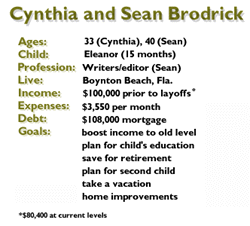|
Disappointed dot.com
|
 |
June 30, 2000: 11:04 a.m. ET
A couple finds themselves freelancing after a virtual-world layoff is all too real
By Staff Writer Alex Frew McMillan
|
NEW YORK (CNNfn) - Checks & Balances runs weekly on CNNfn.com. People with questions about financial planning are invited to write in explaining their financial picture and short- and long-term goals. See the bottom of this article for specifics. For those selected, financial planners will review the details and suggest ways to meet those goals.
The Brodricks have experienced the dot.com employment shakeout first-hand. Both are journalists, and both were laid off from the same Web publishing company at the start of June.
Together they had been making $100,000 a year, sometimes with a little supplemental income from freelancing. But that income evaporated when The Whiz.com, a personal-finance Web site based in North Palm Beach, Fla., cut its staff in half. Now their plans are up in the air.
 Cynthia Brodrick, 33, figures she'll stick with freelance writing, hoping to make $50,000 a year doing that. She says she is coming close at the moment, making around $4,000 a month. Cynthia Brodrick, 33, figures she'll stick with freelance writing, hoping to make $50,000 a year doing that. She says she is coming close at the moment, making around $4,000 a month.
Sean Brodrick, 40, is searching for a full-time job as an editor and writer. He hopes he'll end up with a salary somewhere a little under $60,000. In the meantime, he's making around $2,700 a month temping. He used to work in tabloids, doing celebrity journalism. They have a 15-month old baby, Eleanor, to consider.
Searching for something more stable
They weren't that surprised about the layoffs -- this makes Sean Brodrick's second and Cynthia Brodrick's third time their jobs have been pulled out from under them. So they're used to surviving through freelancing at times.
They also had a sense something was brewing. Dot.com layoffs have been a feature of the first year of the new millennium.
"Like many dot.coms, it was clear something was going to shake up soon. We just didn't know it was going to catch both of us," Cynthia Brodrick says. Cynthia, who also goes by Cindy, had been planning on looking for a new job anyway, she says. "This just eased the transition."
They got a bit of severance pay. But Sean in particular has become more concerned about this kind of job impermanence. He realizes he now has a family to support.
So he's searching for more stable jobs, possibly in journalism, possibly with a career hop to corporate communications. That tends to pay better.
"He's a little burned out on the whole dot.com thing," Cynthia says. "He feels, 'If I was 25, fine. But I have a family relying on me,' that kind of stuff. He feels that pressure."
He's had a few interviews and is pretty confident he can get a decent job in this market.
Perchance to dream, aye, there's the rub
They live in Boynton Beach, Fla., near their old offices. The Whiz.com is owned by the same parent company as Bankrate.com, which, coincidentally, provides content for CNNfn.com.
 After they got laid off, the Brodricks conducted an unexpected self-audit. "We figured out what our basic costs were, without being uncomfortable, and were pleased to see that we can afford to live on our temporary earnings," Cynthia writes. After they got laid off, the Brodricks conducted an unexpected self-audit. "We figured out what our basic costs were, without being uncomfortable, and were pleased to see that we can afford to live on our temporary earnings," Cynthia writes.
She still feels they need some financial-planning advice to restore balance to their precarious position. They would like to have another kid, maybe next year or the year after. They like living debt-free. They like paying into their retirement plans, though that has stopped after their job losses. They would like to take a vacation.
"We had been fantasizing about a trip to Italy next year," Cynthia states. They planned on funding that with her freelancing on top of her salary.
Now all their plans are on hold. She feels they have to put off that Roman holiday a few years, though they would still like to take off for a week somewhere in the States next spring.
Scaling back costs
They own their home, which they bought 18 months ago for $135,000. They put down $27,000, or 20 percent, which means they avoided private mortgage insurance. Cynthia says she is "quite proud" of their 6.8 percent mortgage. They pay $1,000 a month on that.
They've made some improvements on the house, even though it's only four years old. With their strong local housing market, she feels sure it's now worth around $150,000.
They have saved something like $100,000 in retirement plans -- the amount has been fluctuating with the ups and downs in the market this spring -- and another $30,000 in their IRAs. They also have some emergency funds, with $13,000 in checking and credit union accounts and $14,000 in a money market account and stocks.
They had been scaling back their costs, anticipating potential layoffs. Beside their mortgage, they have a monthly payment of $383 on a 1999 Dodge Grand Caravan minivan. They have a second car, a 1998 Honda Civic that they've paid off.
They try to keep down their other household expenses. They'll have to get COBRA health insurance through their old employer, Cynthia figures, though they don't know how much that will cost.
Where do we go from here?
Short-term they want to make some home improvements and add a screened-in porch, all of which they figure will cost $8,000. But they wouldn't rule out moving, particularly if it meant a better job for Sean.
They also want to start a college fund for their daughter, Eleanor. So far she only has $750 in a CD. Before their salaries stopped, they wanted to put $4,000 away this year and $2,000 a year after that, until she is 17.
They also want to get back to funding their own retirement, and they have a few other ideas.
"Eventually we would both like to work from home," Cynthia writes. The couple would like to buy a bigger home down the line, too, particularly if they have another kid.
"Are we doing OK even though we've lost our jobs and don't have that guaranteed income and benefits anymore? How long could we do OK?" she asks.
What the planners say:
Are they OK? A big concern for Janet Tyler Johnson, a certified financial planner with SVA Planners in Madison, Wis., is their apparent lack of life insurance and disability insurance.
"Even with full-time employment, these issues should be examined," she thinks, but it's key when neither spouse has benefits.
Their COBRA will also run out after 18 months, Johnson continues. "With plans on having another child, health insurance will be another major concern."
Those issues take precedence over the longer-term goals of college funding and retirement planning, Johnson says. "An untimely death or disability will undo the best of financial-planning strategies," she writes.
A solid base to build from
Kim Dignum, a certified financial planner with Dignum Financial Services in Fort Worth, Texas, thinks the Brodricks have a good base to build from, though. Their net worth is $275,500, Dignum estimates, meaning they've got a debt:asset ratio of 1:3, which she says is a good balance.
"They appear to be very disciplined in this area and have avoided significant amounts of debt. This is excellent," she explains.
They've also come at their unfortunate layoffs with good judgment, Dignum thinks. "They have reviewed their budget and determined exactly what income they need to maintain their current lifestyle." In fact, according to Dignum they still have positive cash flow, with $1,390 in discretionary income after the expenses they submitted.
They've also done well to create emergency funds to fall back on. The money they have in checking, credit-union and money-market accounts is more than sufficient, according to Dignum, who recommends that her clients sit on a cushion of at least three months of operating expenses, to cover the mortgage, food and the like.
Tackling those college costs
Rather than think about home improvements at the moment, though, they should use their discretionary income to target their goals of college funding and retirement planning, Dignum says. Just as well to put the Italy trip on hold, too.
If Eleanor Brodrick ultimately attends a state college, Dignum reckons they can get by investing $106 a month in a growth mutual fund, given the $750 CD they already have. Dignum is assuming a 10 percent return on the mutual fund, after tax.
Once they are both working full-time, they could increase that amount to plan for their second child's education. They might want to increase it in case Eleanor chooses a more-expensive college, anyway. Johnson estimates they should invest $240 a month toward her education, far above the amount Dignum recommends.
Raring for retirement
Cynthia Brodrick is correct that the couple should restart contributions to their retirement accounts as soon as possible, the planners said. Dignum recommends that they each set aside $167 a month even now to put toward their IRAs, meaning they'll pump in $2,000 over a year. There should be room for that from the discretionary income they already have, she thinks.
Both planners assume they'll need $100,000 a year in retirement. The planners vary slightly on the exact amount the Brodricks need to set aside each month right now because it's not yet clear when Sean will retire. There's also a little fluctuation in the returns they might expect. The Brodricks could also try and skimp in retirement.
But the planners are not that far apart. Dignum projects that the Brodricks need to invest around $1,360 a month as well as their IRA money, for a total of $1,530 a month. Johnson comes in at about $1,660 a month.
Once Sean starts full-time work, he should make sure he meets those needs through his 401 (k), Dignum says. Because it might take a year for him to qualify for that, Johnson says Cynthia should investigate a Keogh plan.
Dignum has the same idea, but plumps for a Simplified Employee Pension plan, since Cynthia is self-employed. She should be able to set aside $750 a month to help her husband meet the total, according to Dignum.
Dignum's bottom line is that the Brodricks are in reasonable shape to get where they want to, despite being close to unemployed. "They have prepared themselves well for this situation," the planner states.
Though Dignum assumes Sean will find work, their income level seems to allow them to continue toward their goals without "a large degree of lifestyle changes," she says.
* Disclaimer
Got questions about financial planning? Need some advice? CNNfn.com has organized a panel of outside experts to answer your questions. If you want to be considered for the "Checks & Balances" column, where professional planners suggest ways you can manage your money, send us an e-mail at checksandbalances@cnnfn.com. Include information about your age, occupation, income, assets and monthly expenses -- imagine you're providing a full income statement and balance sheet. Also, share with us any short-term and long-term financial goals you may have. And don't forget to leave your phone number. 
|
|
|
|
|
 |

|

